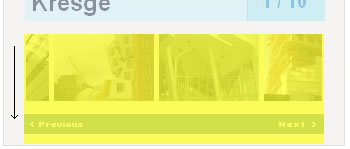The code on the previous page was just a setup to the real code
that is, coincidentally, on this page. Let's take a look at the
thumbnails_fn function that I briefly mentioned towards the end
of the last page:
Before going through the code line-by-line, let me explain
what this function does. The thumbNailScroller function, as its
name implies, helps scroll the thumbnails when the mouse moves
over the left or right boundaries. Most of the above code lies
in determining when to start and stop the scrolling:
- this.createEmptyMovieClip("tscroller",
1000);
I'm creating a new, empty movie clip called tscroller
at a depth of 1000.
- scroll_speed
= 10;
The variable scroll_speed controls how fast all of the
thumbnails scroll left or right.
- tscroller.onEnterFrame
=
function()
{
I'm specifying the onEnterFrame of the newly created
tscroller movie clip. If you recall, onEnterFrame executes
any code contained within it repeatedly unless you explicitly
delete the onEnterFrame.
- if ((_root._ymouse>=thumbnail_mc._y)
&& (_root._ymouse<=thumbnail_mc._y+thumbnail_mc._height))
{
The above if condition checks to make sure that the thumbnail
scroller works only when our mouse is contained within the
vertical (y) constraints of the thumbnail_mc movie clip.
The following diagram shows the constraint imposed by
_root._ymouse >= thumbnail_mc._y. Anything beyond the top border
of the thumbnail is fair game:

But, I also include an extra constraint to make sure that the
thumbnails don't scroll when your mouse is below the thumbnail
such as the Previous and Next buttons. That is fixed by the
_root._ymouse<=thumbnail_mc._y+thumbnail_mc._height
code.
Thumbnail_mc._y
gives the numerical value of the top border of your thumbnails,
and thumbnail_mc._height gives you the total height of your
thumbnails. The total y position then, is the sum of both the y
position of the top thumbnail border and the total thumbnail
height.

Each of the above two constraints by themselves are not very
practical. But, both of them combined with the && operator
produces just the right vertical boundary I need, as seen by the
combination of the blue and yellow rectangles as the green
rectangle shown below:

The next course of action would be to limit the
horizontal range of movement. You wouldn't want to have the
thumbnails scroll when your mouse cursor is well to the left or
right of the actual photo gallery area!
The right boundary of our horizontal scrolling
is determined by:
- (_root._xmouse>=(hit_right._x-40))
&& (thumbnail_mc.hitTest(hit_right))
I check for two things. First, I check to see if
the mouse cursor is 40 pixels to the left of the right-most
boundary of our hit_right movie clip.
Second, I make sure that the thumbnail_mc movie
clip is hitting hit_right. Even though, due to the mask, it
looks as if all of the thumbnails are neatly contained within
the viewing area, in reality, the thumbnails extend well towards
the right-end of the screen provided there are enough images.
The hitTest makes sure that the thumbnail_mc
still is hitting the hit_right movie clip. In other words, it
makes sure there are still images left for us to scroll. I
wouldn't want you to keep scrolling indefinitely after all of
the thumbnails have left the viewing area!
The complement of this is the boundary for the
left side of our thumbnail scroller:
- (_root._xmouse<=(hit_left._x+40))
&& (thumbnail_mc.hitTest(hit_left))
I do the same thing as I did for the right boundary, except I
change a few signs and movie clip references. Like before, I
check to make sure that the mouse is within a reasonable area on
the left side before the scrolling is invoked, and I also make
sure that there are images left to scroll by using the hitTest
function.
- thumbnail_mc._x
-=
scroll_speed;
If both the vertical and horizontal right boundary conditions
are met, that means we are interested in scrolling our images to
the left. Therefore, I have the code set to move thumbnail_mc in
the horizontal direction at a speed determined by the
scroll_speed variable.
- thumbnail_mc._x
+=
scroll_speed;
Likewise, if both the vertical and horizontal left boundary
conditions are met, I scroll the thumbnail_mc movie clip to the
right at the speed determined by scroll_speed.
- if
((_root._ymouse>=thumbnail_mc._y)
&&
(_root._ymouse<=thumbnail_mc._y+thumbnail_mc._height))
{
- if
((_root._xmouse>=(hit_right._x-40))
&&
(thumbnail_mc.hitTest(hit_right)))
{
-
thumbnail_mc._x
-=
scroll_speed;
- }
else if
((_root._xmouse<=(hit_left._x+40))
&&
(thumbnail_mc.hitTest(hit_left)))
{
-
thumbnail_mc._x
+=
scroll_speed;
- }
- }
else
{
- delete
tscroller.onEnterFrame;
- }
The structure of this if statement is something that I have
not used in any of my tutorials before. It is an if - else if
form. Normally, there would be an if statement and an else
statement, but I wanted to have one extra condition for
executing code.
This is a nicer way of combining to if statements together,
and you would suffer no loss in functionality if you decided to
use two if statements instead.
- delete
tscroller.onEnterFrame;
I check to see if the mouse cursor is within the vertical
area of the thumbnail, and if the mouse cursor is not there,
that means that the user has scrolled and moved his/her mouse
cursor away from the scrolling area.
Since having onEnterFrame loop continuously can be taxing on
the CPU, it is good to delete them. Since our
thumbNailScroller() function is called each time you hover over
a thumbnail, a new empty 'tscroller' movie clip is created with
a new onEnterFrame also being initiated. In other words, the
deletion is only in effect until you call the
thumbNailScroller() function again.
On the next page, I will do a lightning round summary of the
six pages you've clobbered through already!
 |
page 6 of 7 |
 |